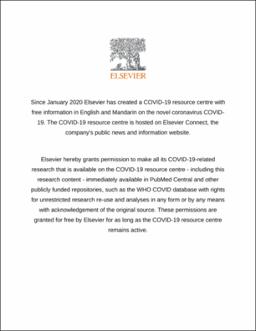Preeclampsia and COVID-19: results from the INTERCOVID prospective longitudinal study

View/
Date
2021-09Author
Risso, Milagros.
Papageorghiou, Aris.
Deruelle, Philippe.
Et al.
Metadata
Show full item recordAbstract
Abstract
Background: It is unclear whether the suggested link between COVID-19 during pregnancy and preeclampsia is an independent association or if these are caused by common risk factors.
Objective: This study aimed to quantify any independent association between COVID-19 during pregnancy and preeclampsia and to determine the effect of these variables on maternal and neonatal morbidity and mortality.
Study design: This was a large, longitudinal, prospective, unmatched diagnosed and not-diagnosed observational study assessing the effect of COVID-19 during pregnancy on mothers and neonates. Two consecutive not-diagnosed women were concomitantly enrolled immediately after each diagnosed woman was identified, at any stage during pregnancy or delivery, and at the same level of care to minimize bias. Women and neonates were followed until hospital discharge using the standardized INTERGROWTH-21st protocols and electronic data management system. A total of 43 institutions in 18 countries contributed to the study sample. The independent association between the 2 entities was quantified with the risk factors known to be associated with preeclampsia analyzed in each group. The outcomes were compared among women with COVID-19 alone, preeclampsia alone, both conditions, and those without either of the 2 conditions.
Results: We enrolled 2184 pregnant women; of these, 725 (33.2%) were enrolled in the COVID-19 diagnosed and 1459 (66.8%) in the COVID-19 not-diagnosed groups. Of these women, 123 had preeclampsia of which 59 of 725 (8.1%) were in the COVID-19 diagnosed group and 64 of 1459 (4.4%) were in the not-diagnosed group (risk ratio, 1.86; 95% confidence interval, 1.32-2.61). After adjustment for sociodemographic factors and conditions associated with both COVID-19 and preeclampsia, the risk ratio for preeclampsia remained significant among all women (risk ratio, 1.77; 95% confidence interval, 1.25-2.52) and nulliparous women specifically (risk ratio, 1.89; 95% confidence interval, 1.17-3.05). There was a trend but no statistical significance among parous women (risk ratio, 1.64; 95% confidence interval, 0.99-2.73). The risk ratio for preterm birth for all women diagnosed with COVID-19 and preeclampsia was 4.05 (95% confidence interval, 2.99-5.49) and 6.26 (95% confidence interval, 4.35-9.00) for nulliparous women. Compared with women with neither condition diagnosed, the composite adverse perinatal outcome showed a stepwise increase in the risk ratio for COVID-19 without preeclampsia, preeclampsia without COVID-19, and COVID-19 with preeclampsia (risk ratio, 2.16; 95% confidence interval, 1.63-2.86; risk ratio, 2.53; 95% confidence interval, 1.44-4.45; and risk ratio, 2.84; 95% confidence interval, 1.67-4.82, respectively). Similar findings were found for the composite adverse maternal outcome with risk ratios of 1.76 (95% confidence interval, 1.32-2.35), 2.07 (95% confidence interval, 1.20-3.57), and 2.77 (95% confidence interval, 1.66-4.63). The association between COVID-19 and gestational hypertension and the direction of the effects on preterm birth and adverse perinatal and maternal outcomes, were similar to preeclampsia, but confined to nulliparous women with lower risk ratios.
Conclusion: COVID-19 during pregnancy is strongly associated with preeclampsia, especially among nulliparous women. This association is independent of any risk factors and preexisting conditions. COVID-19 severity does not seem to be a factor in this association. Both conditions are associated independently of and in an additive fashion with preterm birth, severe perinatal morbidity and mortality, and adverse maternal outcomes. Women with preeclampsia should be considered a particularly vulnerable group with regard to the risks posed by COVID-19.
Keywords: SARS-CoV 2; aspirin; cohort; gestational hypertension; hypertension; hypertensive disorders in pregnancy; infection; morbidity; mortality; obesity; overweight; preeclampsia; pregnancy; preterm birth; proteinuria; relative risk; renal disease; risk ratio; small for gestational age.
Copyright © 2021. Published by Elsevier Inc.
PubMed Disclaimer
Collections
The following license files are associated with this item:

